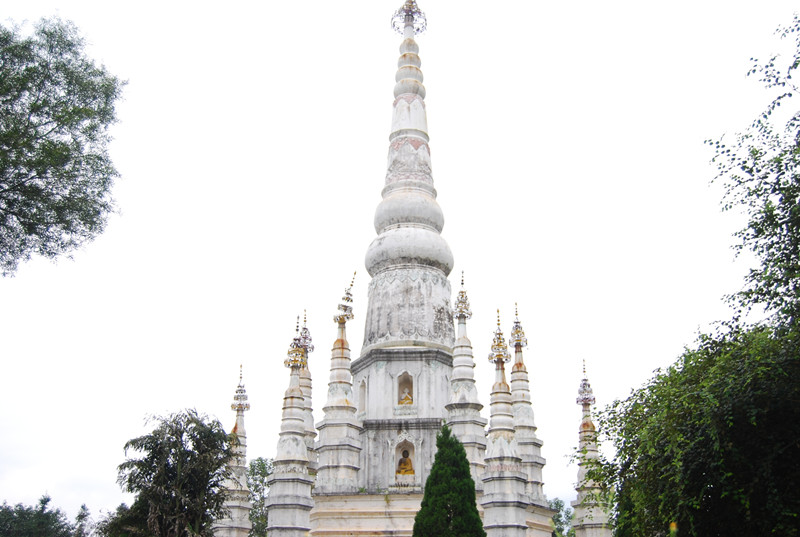
Jingge White Pagoda in Gengma County, Lincang
Overview
- Entrance Fee: Free
- Address: Jingyun Ethnic Middle School, Gengma County (耿马县, Gěngmǎ Xiàn)
- Type: Historical Architecture
- Recommended Visit Duration: 1 hour
Attraction Introduction
The Jingge White Pagoda (景戈白塔, Jǐnggē Bái Tǎ) is located within Jingge Park (景戈公园, Jǐnggē Gōngyuán) in Gengma County (耿马县, Gěngmǎ Xiàn), Lincang (临沧, Líncāng). Originally built in 1778 during the reign of the 14th local chieftain, Han Chaoyuan (罕朝瑗), the pagoda was constructed to commemorate the friendly relations between China and Myanmar. It is celebrated during the Water Splashing Festival, with designated days of “Ding” or “Ren” for the ritual known as “Gan Baitai” (赶白塔).
In 1988, a significant earthquake damaged the upper part of the pagoda, which was subsequently rebuilt in 1991. The main tower stands at 30 meters, symbolizing the celestial body of the Buddha. Legend has it that upon the Buddha’s nirvana, he transformed into thirteen “relics” (舍利子, shèlìzǐ), leading to the construction of 13 pagodas at Jingge, including the main one and 12 smaller accompanying towers representing the 12 major disciples.
The main and auxiliary towers are constructed of brick and stone, with their pointed caps intricately crafted from alloys and coated with gold leaf, shining brilliantly in the sunlight. To the south of the main tower, two Qilin (麒麟, qílín) statues serve as guardians and steeds of the Buddha. Surrounding the main tower are twelve statues of various Buddhas, including Sakyamuni (释迦牟尼, Shìjiā Móuní), Guanyin (观音, Guānyīn), Maitreya (弥勒佛, Mílè Fó), and nine Vajra Arhats (金刚罗汉, Jīngāng Luóhàn). Each statue expresses a range of emotions, from benevolence to joy, contemplation, and even laughter.
During the “Gan Baitai” event, local residents gather at the base of the tower to offer incense and pray. Young people celebrate by drumming and dancing in lively groups from their villages.
Local Significance
The Jingge White Pagoda is not only a significant cultural monument but also a representation of the harmonious blend of Chinese and Dai architectural styles. Located near the China-Myanmar border, Gengma County (耿马县, Gěngmǎ Xiàn) features structures that reflect this unique cultural mix, making the pagoda an important landmark in the area.
How to Get There
To reach the Jingge White Pagoda (景戈白塔, Jǐnggē Bái Tǎ) in Gengma County (耿马县, Gěngmǎ Xiàn), it is advisable to navigate using a GPS service as public transport options are limited. Self-driving or riding a motorcycle is the most convenient way to access the pagoda.
Travel Tips
- Best Time to Visit: Early morning or late afternoon for cooler temperatures and better lighting for photographs.
- Respect the Site: While there is no entrance fee and visitors are free to take photos, please be respectful of the pagoda and its religious significance.
- Safety Precautions: Wear comfortable shoes as the area may involve walking on uneven ground.
- Local Food: Explore local cuisine at nearby eateries to enhance your cultural experience.
- Check Local Events: If visiting during the Water Splashing Festival, be sure to participate in the festivities for a unique experience.




















